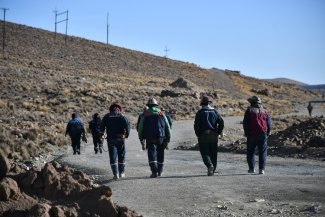

In July 2013, Croatia became the 28th member state of the European Union, which resulted in a massive boost for its tourism industry. But now over-development is now threatening the Plitvice Lakes National Park.
Sixteen pools of crystal clear water and a chain of small and big waterfalls, surrounded by luxuriant green vegetation. The Plitvice Lakes are Croatia’s postcard image of paradise on Earth, now threatened by a huge upswing in tourism, development and pollution.
So much so that UNESCO (the United Nations Educational, Scientific and Cultural Organisation) will consider in June whether to put the Plitvice Lakes National Park, which is currently on the World Heritage List, on its List of World Heritage in Danger instead. The park runs the risk of losing its coveted status if doesn’t act quickly.
Turning up the pressure, a group of Croatian war veterans organised a protest camp in the village of Plitvica Selo to draw attention to the excessive levels of construction within the area of the Plitvice Lakes National Park. Their sit-in lasted over 100 days, drawing the media attention they had hoped for. Unfortunately, the government didn’t react.
Ivica Jandrić is one of the leaders of the movement. He grew up in the area and is well-aware of the damage caused by tourism-related development.
“These houses get the water they need directly from the lake basin and empty their waste water into the surrounding land,” explains Jandrić. He shows Equal Times what locals sarcastically call “the 17th lake”, a foul-smelling pool serviced by an unidentified drainpipe.
“I remember very well when there was drinking water at the bottom of the great waterfall. I have an old picture of me drinking from it right here,” says the veteran.
Although in his youth Jandrić was able to drink water directly from the lakes, doing so today would likely be hazardous to his health. Detergents, pesticides, fecal matter: in the Plitvice Lakes, these substances are found in abnormal quantities, according to a study carried out at the end of July 2017 by the Croatian Institute of Public Health.
The Plitvice Lakes National Park is located in central Croatia, an hour and a half drive from the country’s capital, Zagreb. It is the oldest and largest national park in the country, covering an area of around 300 km2 and boasting a unique ecosystem.
Nature has formed countless barriers of travertine in Plitvice, the limestone rock that gives life to the area’s famous waterfalls, creating a space in which flora and fauna can thrive.
The park is home to about “20 endemic plants, 350 species of butterflies, 42 different types of dragonflies and 21 varieties of bats, as well as bears, wild boar and deer,” explains Helena Petrović, a guide at the national park, while walking next to the turquoise lakes.
Employed in Plitvice since 1979, the year when the park ascended to UNESCO’s famous list, Petrović has the measured pace of those who know the route by heart. With a red umbrella in her hand, she points to the waterfalls and lakes, and tells the story of one of Croatia’s most precious jewels.
“The park has not changed much in all these years,” says Petrović, looking down at the lakes. “What has really changed is all that revolves around it,” she adds.
A tourism and construction boom
Where there is exceptional natural beauty, there is tourism. Croatia is one of the countries investing the most in this sector, boosted in part by European Union membership five years ago. It is no surprise then that the figures show a dramatic increase in the number of visitors.
In 2017, this country of around four million inhabitants recorded 18.5 million tourist visits, and an income from travel and tourism representing 24 per cent of the total GDP. A fair share of these tourists ended up visiting Plitvice. Since 1979, the annual number of visitors has increased from 500,000 to 1.7 million in 2017, with a daily peak of 17,000 admissions last August.
The park’s flora and fauna has inevitably suffered from such high tourist footfall. Especially because many visitors do not follow the designated paths and itineraries. Many try, despite warnings, to swim in the turquoise waters of the lakes, feed the fish or leave food for other animals.
Such behaviour threatens not only the park’s ecosystem, but sometimes even the tourists themselves. After a couple of visitors fell into the water while taking photographs (occasionally with fatal consequences), in the summer 2016 the Croatian mountain rescue service issued this blunt warning: “Dear tourists, we respect you. It’s time for you to start respecting yourself. So, stop making stupid and dangerous selfies.”
However, there is a much more serious, albeit, less visible threat to the Plitvice Lakes, and it comes from the increase in private construction around the park. Behind the largest waterfall, Veliki Slap, which connects the lake system to the Korana River, lies the village of Plitvica Selo. Here, bulldozers and trucks are working 24/7 to build apartments, guesthouses, villas and other types of accommodation.
Since the end of the war in Croatia in 1995, when the first houses were built in what was at the time an almost deserted area, hundreds of structures have been constructed, mostly over the last five years.
A new plan was adopted by the government in 2014, redefining the notion of “protected areas” and enabling further construction. Private investors – both small and large, foreign and (mainly) domestic – took advantage of this shift.
“In the municipalities of Plitvica Selo and Plitvička Jezera alone, the number of private apartments rose from 16 in 2009 to over 300 in 2017, with a jump in overnight stays from 600 [in 2009] to over 30,000 [in 2017],” says Andjelko Novosel, a former director of the National Park.
According to Novosel, who was the park’s conservation manager from 2012 to 2016 and its director from 2016 to 2017, the park administration has no say in the matter. He describes “strong pressure” from private investors.
“They wanted me to open a third entrance to the park, closer to their properties, but I refused. I hope that the new management will continue to do so,” he says.
“The owners of those establishments print their own maps of the park and independently guide the visitors inside it. They allow them to use bicycles...in short, they challenge the authority of the national park,” he adds.
Too late to save Plitvice?
Novosel is far from the only person concerned by excessive construction in and around the lakes. Zagreb-based NGO Zelena Akcija (Green Action) has been following this issue for several years, taking part in roundtable discussions organised by the government with local stakeholders.
One of the major issues concerning the increasing number of facilities in the park is, as the NGO points out, that the new construction is not connected to any sewage system.
“The distribution of building licenses in the protected area is not done anymore at a state level, but by local authorities,” explains Hrvoje Radovanović, a programme assistant at Zelena Akcija. On the question of how private investors get licences without a working sewage system, Radovanović says the answer is simple: corruption.
The mayor of Plitvice, Ante Kovač, assures Equal Times that local authorities and the state government are currently trying to solve the problem of the “17th lake”, which has become a regional and international issue.
“The feces from Plitvice end up in drinking water in Bihać, in Bosnia and Herzegovina,” says Kovač says, emphasising the extent of the problem. He says that all stakeholders are currently discussing the construction of a wastewater management plant, but the problem now is money.
If on one hand they apply for European Union funds to subsidise the plant construction, the new sewage system will significantly increase the cost of living for locals, who would end up paying higher water bills to keep the plant running, in one of the least inhabited and poorest regions of Croatia. It would be up to the government to step in and find a way to cover those costs.
“The state, especially the Ministry of Environment, has to decide if Plitvice National Park represents a strategic interest for the country”, says Kovač, adding that the lion’s share of the income generated by ticket sales from the park goes directly to the state; only 6 per cent goes to the local municipality.
A UNESCO mission visited the park in January 2017 and raised concerns about the excessive construction and pollution.
“Due to the growing demand for housing and business opportunities, there is a rapid growth in properties, with many old farms and other buildings being transformed and expanded into tourist facilities,” reads the report approved last July by the World Heritage Committee.
The mission submitted a list of various measures to be urgently undertaken, warning that “if no substantial progress...is achieved by 2018…the mission recommends that the World Heritage Committee (WHC) consider inscription of the property in the List of World Heritage in Danger at its 42nd session in 2018.”
Questioned in an email on the issue of pollution and excessive construction in Plitvice, the Croatian Ministry of Environment and Energy said that it was confident about the park’s future.
"We believe that UNESCO will recognise our efforts and the intense work undertaken in all sectors,” said a ministry spokesperson, highlighting the creation of a working group, inspections at the construction sites, and the creation of a local programme to develop the water and sanitation infrastructure necessary for new housing.
The UNESCO mission confirmed it had received a report from the Croatian government which addresses the expansion of tourist facilities and visitor numbers, the restoration of the water supply and drainage system, and cooperation with local stakeholders.
But it remains to be seen whether the World Heritage Committee, when it meets in June in Bahrain, will decide that Croatia’s efforts are enough to keep Plitvice off the ‘danger’ list.









